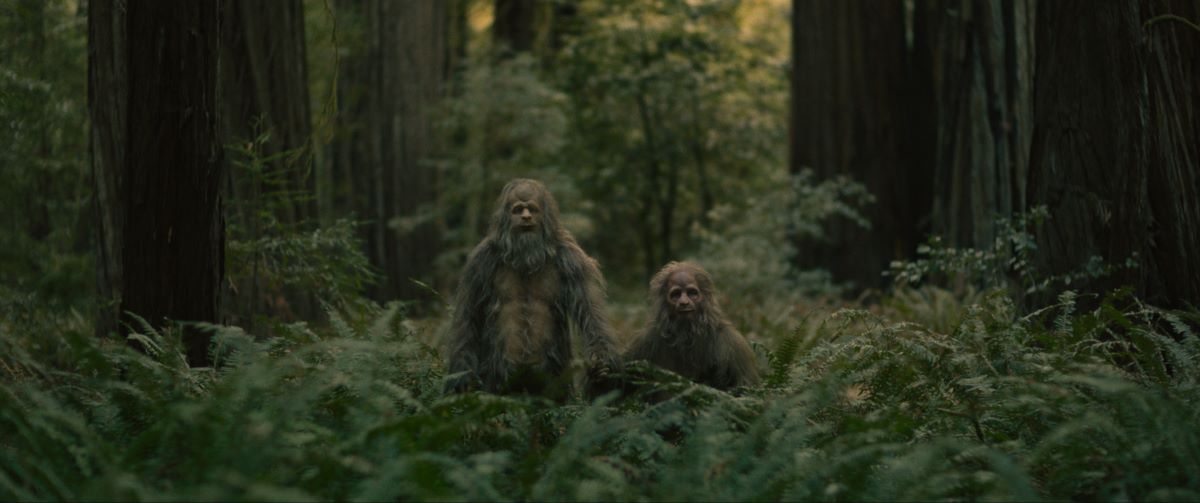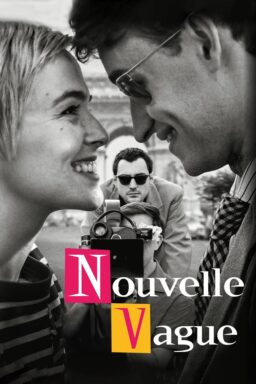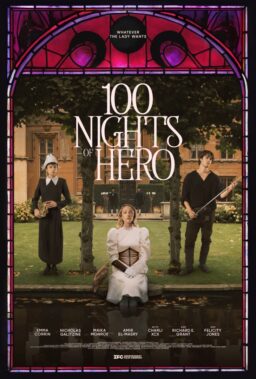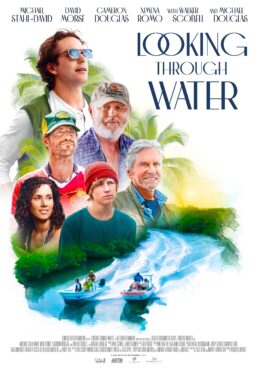Every film from David and Nathan Zellner—the writing/directing duo behind “Damsel” and “Kumiko the Treasure Hunter”—has a moment when the laughter stops, and the grim reality their protagonists must face sets in. The brothers adore misfits, finding space to center a lovesick drifter toting a mini-pony or a deeply depressed Japanese woman looking for the fictional cash in “Fargo.” These are characters pining for belonging, but instead are hit by the cruel hand the universe uses to keep such pleasures away. Their newest film “Sasquatch Sunset,” which premiered at Sundance Film Festival, might be their silliest and their most heartbreaking.
The film follows a family of Sasquatches—played by Nathan Zeller, Riley Keough, Jesse Eisenberg, and Christophe Zajac-Denek—migrating across their woodland habitat in search of their kind. In the early going potty humor abounds: literal shit throwing, flatulence, and horndog carousing. Halfway through you come to wonder if the film is merely an opportunity for the Zellners to play in the forest, giving into their basest instincts as they push the limits of good taste. And yet, a poignancy, which seemingly arrives as casually as the changing seasons, ever so slowly creeps up on the viewer. This isn’t just a piss take. “Sasquatch Sunset” is a deeply tragic work about the loss of family, the looming threat of loneliness, the crumbling environment, the pernicious souls of mankind, and the helpless animals left in man’s wake. The Zellners dare to invoke empathy in the viewer without ever putting humanity at the center. Rather “Sasquatch Sunset” asks you to care about life, no matter how primitive a form it may take.
RogerEbert.com spoke to the Zellners during the Berlin International Film Festival at the Hyatt’s Vox Restaurant about selling a film about Sasquatches, designing the costumes, and how they overcame the elements to make their most audacious picture yet.
I first watched “Sasquatch Sunset” at Sundance, and it’s a pleasure to see it again in Berlin. Your films always start off as silly larks, and then at some point, a kind of poignancy sneaks up. This one has a lot more absurd slapstick moments that naturally blend into a type of family drama. And yet, the dialogue is mostly grunts and groans. How did the script read? Is it more sensorial?
David Zellner: It was shorter than a regular script. We had about 60 pages. It described what was going on in their heads and what they were thinking and feeling and how they were expressing it, whether it’s through grunts or facial expressions or physical meetings. Because it’s an unconventional project, it was essential that we had as much clarity as possible of what we were trying to accomplish for the cast, crew, financiers, and everyone involved. Especially with the specific tone, the mix of pathos and humor.
What was the writing process like? Because I assume the writing must have required acting out these scenes to get the tone right. So did it amount to trading grunts?
DZ: We kind of knew, like with the vocalizations, that we didn’t want to have them be dubbed with animal sounds or some synthesized vocalization. We wanted to try as much as we could to find ways to connect to the characters on a personal level. So we wanted the actors to be making those actual sounds. And for that same reason we didn’t want their eyes covered with anything. We wanted to be able to see into their soul in a certain way. It was as specific as we could get with the script. But then in the preparation, both over zoom leading up to it, we got everyone together and took it to the next level by figuring out their commonalities and to make sure there was a baseline for their vocalization and their behavior.
I’m very interested in the vocalization because I think each is so unique. How did you work with the actors on bringing out those voices? Nathan, you play one of the Sasquatches, how did you work on your voice?
Nathan Zellner: We watched a lot of primate videos. We thought about a very basic kind of communication, like a few simple noises or syllables instead of building a really elaborate language of different noises for different things. These grunts kind of just came with riffing back and forth of what it might sound like. And then once we all kind of got on the same page, it all came very natural. The whooping came from watching some other primate videos and how primates kind of call to each other in the forest. There was also a little bit of Sasquatch folklore, reports of sightings where they hear strange calls in the woods and attribute it to Bigfoot, you know? And so we knew having them call out to each other in a certain way would be another way that they can communicate across distances and show stress or whatever.
Did the beating of the trees come from Sasquatch folklore?
DZ: Well some of that comes from Bigfoot experts. There are videos online where people claim they’re in the woods and they’re hearing knocking sounds, some tree knocking sounds in the distance. So we took that idea and made our own versions of that.
Other than primates, were there any other animals that inspired the physicality and the sounds of the Sasquatches?
DZ: Mostly primates. I’d also say a lot came from growing up with pets like dogs and cats. There’s so many things in the movie that we witnessed our dogs and cats do when we were growing up in terms of marking territory, mating and social behavior, and the way they interacted with each other. Some of the most extreme stuff I feel like we took from either personal experience with animals or from videos online.
I love that you convinced people to bankroll all of this.
NZ: It took years. It was very tough.
DZ: Thankfully, it was a combination of people being familiar with our other work and then just doing a good job on our end to pitch why this is a singular project and what we were trying to accomplish with it. It took a while to find those people who were on the same page.

What was the elevator pitch?
DZ: It was basically we’re following a family of Sasquatches over the course of a year. I mean, the closest comp, even though it’s not that close, would be some of the animal movies from the 1970s, almost like Disney films where they’re following a pack of wolves. Because we always wanted this to be through their perspective, not through interactions with humans. We wanted it to be as much from their point of view in the world as though it was a story about any other family of animals like wolves or bears or whatever.
I love the Sasquatch costumes and that they’re practical. Because of course, stuff like the newer “Planet the Apes,” are mostly motion captured. How did you go about designing the costumes in terms of making them practical to use on set but also fitting the folklore while putting your own spin on it?
NZ: Anytime you can do practical, we think it’s just better. I think it makes it feel more realistic.
DZ: There’s a tactical quality.
NZ: Yeah. And since we wanted to make this naturalistic and make everything believable, it was very important not to use CG augmentation or CG animals. Everything had to have a realness to it. In terms of designing them, we had a lot of talks with our makeup and effects guy, Steve Newburn, about what we wanted to get out of their facial expressions and how we wanted the actors to be able to express themselves through the makeup. David might have said it, but like, we wanted to make sure you could see their eyes and really have a human connection through the eyes. Because I think even when you look at any animal, you can see them look at you in a certain way, there’s an instant familiarity there. That was important.
And then we took some aspects from what we think we know of the stereotypical Sasquatch. My character is definitely more what most people picture when they think of Bigfoot. Some of the other characters have a little bit different personalities put in there. But then the actors came once we had a foundation, and then they came and added a lot more to it. They were able to add character to these creatures that kind of helped elevate them beyond what the baseline was.
What was it like wearing the Sasquatch suit, and how did it play in the natural elements?
NZ: We shot it in the fall up in Northern California. So we had pretty mild temperatures. We dealt with a lot of fluctuation with rain, and we even got a snowstorm, which worked out really conveniently because that was the day we were shooting some of the winter stuff. We went up into the mountains a little bit higher to get some of that. But they were all form fitted. Like we did a full body cast. That way it didn’t look like the suit was moving. It looked like your muscles were actually moving.
So it was pretty restrictive, and they were very heavy as well because it’s like a whole foam suit and then a whole layer of fur on top of it. It took two hours in the chair getting the face and the hair glued on. But it was a lot of fun. Even though it was really uncomfortable, every day it was just fun to be out in the woods in that environment, in these costumes and doing these ridiculous scenes.
And, of course, at some point you probably just fall right into character just by being in costume.
NZ: Exactly.
I’m wondering about the balance of being animalistic while viewing these characters with humanity.
DZ: It was very much an intuitive process, rather than intellectualized because that was one of the things that was most interesting to us. It was finding and exploring the gray area between human and animal behavior, the relatability, but then also the discomfort and humor and everything that comes from that kind of intersection of those traits. We followed some things within the mythology, but there was also some room to make our own rules within that. But I think you could say both humans and animals exhibit these same traits, but in maybe more repressed ways [laughs].
Were either Jesse or Riley well-versed in Sasquatch lore before they came on?
DZ: Riley was more so than Jesse. I mean, they’re both obviously familiar with it. But I think Riley was maybe a little more familiar because she said her dad was from Oregon and was very immersed in the lore and had had an encounter when he was younger. So the lore was of interest to them to a degree, but it was the opportunity to do something they haven’t been able to do before, finding other ways to express themselves. So we were nervous about sending the script to them. But it was the kind of project where either you get it or you don’t. Very quickly, they both got it and were dialed in.

Slightly off topic, but my partner is from Northern California and is a big Bigfoot fan.
DZ: She’s from the epicenter!
She’s from Alturas, part of the Northstate.
DZ: We filmed in Humboldt county, so she’s probably east of that?
Yeah. Not too far away from Mount Shasta.
NZ: There’s a lot of crazy stuff up there!
DZ: That stuff with the people that live in the mountains. Do you know all that?
NZ: The Crystal Peak.
DZ: What do they call the people who live inside of Mt. Shasta? There’s a certain name.
NZ: It’s a lost continent that went into the mountains.
DZ: Lemuria? It’s like a lost civilization millions of years ago went into that mountain.They’re partly connected to Bigfoot as well. It’s all mixed together!
I heard you brought on a movement coach to work on the physicality of the Sasquatches.
NZ: He was someone that Jesse brought on because he had worked with him on another film. And the movement coach had worked under Marcel Marceau. He was really good talking through and helping us all think through how animals interact with things. Like a lot of the early stuff we did over Zoom was walking around our rooms and finding items and trying to experience them as if we had never seen it before. Even if it was something as simple as a plate. For some animals, it’s not all about looking at it. They might like to taste it or smell it or feel it a certain way. That helped everyone kind of think through how your hand positions might be or how you would walk through these environments or interact with little things like twigs or branches.
DZ: It was also beneficial in terms of just everyone getting comfortable with each other and feeling uninhibited. Trust was so important. If the actors were restrained in these performances, the performances would’ve really suffered.
This film, much like the rest of your work, switches from a kind of zaniness to being bleak. Here that change comes from human encroachment. Could you talk about how early that theme came into view?
DZ: I think from the start. There was no other way to tell the story without looking at the impact of humans on the natural world.
Well, in another person’s hands, the film could have easily been strictly cartoonish.
DZ: Oh, yeah. That was something from the start we tried to do in general. We like having a mix of humor and pathos and kind of taking things that in another context could be kind of slight, and then giving them a certain reverence. And I mean, we actually care about the characters. We want to sustain interest in the film itself, but also we just want to have it work in terms of the kind of art that we respond to, where it works on different levels and people can take different things from it.
You mentioned earlier about the snowstorm. Were there any other weather-related challenges?
DZ: Rain and snow mostly. There’s a sequence on the river that was very difficult, that was the hardest part of the movie. From when we scouted to when we shot, the water temperature dropped over 30 degrees. It changed drastically. The rains came and then flooded these springs and then put ice cold water in the river. And any kind of water work is always a challenge, but we knew that would be the toughest sequence. But it was essential because like Nathan said, we wanted to legitimize these creatures by incorporating as many naturalistic elements as possible. That’s why everything was shot on location and why we used real animals, so we could ground the creatures.
NZ: We got lucky a couple times. Because one of the rainiest days was the funeral scenes. There’s nothing sadder than a funeral in the rain. But yeah, even from the early stages, we always wanted to spread it out over a year to go from spring to winter.
The funeral scene might be my favorite because we go from these being somewhat mindless creatures to them having rituals.
DZ: The ritual was important for us partly to play into Bigfoot lore, but then also to show a certain level of complexity to their social dynamic.
NZ: And to add a little bit more, that’s the dial between human and animal, civilization and the wild to make something that feels a little bit more sophisticated while also keeping it very simple—like in the funeral scene where they all cover their eyes. It feels so heavy because of everything else that you’ve seen of them.
What do you hope audiences take from this film?
DZ: We’re fine with people taking different things from it. Sometimes it’s nice with some of our other work where two people side by side have completely different takes. We like films that leave some breathing room for you to add your own interpretation to it instead of it being constantly fed to you. But I mean, since we were children we’ve been obsessed with Bigfoot lore. It’s something we wanted to treat with a certain reverence, but at the same time embrace the inherent humor that comes with the intersection of human and animal behavior.
NZ: it’s always fun to see what people take from it. So far, some of my favorite reactions have been people saying, “That was not what I expected.” [laughs] Or I didn’t know what to expect and I was surprised by this.
DZ: And of course, it’s intentional, where we front load it with more of the borderline slapstick humor.
NZ: Also, just because we’ve sat with the edit for so long and have been analyzing every little thing, there’s a lot of little details. I’ve seen a couple people post that they’ve seen it now a second time already and how they’ve picked up on some of the little traits that were seeded in the beginning and how they pay off. That’s been very fun.












